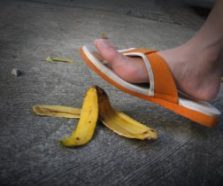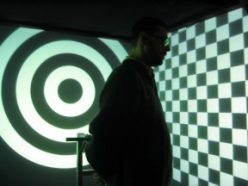Taking a Spill for Science
Studying how and why people fall provides insights into movement and balance.
Share this:
- Share via email (Opens in new window) Email
- Click to share on Facebook (Opens in new window) Facebook
- Click to share on X (Opens in new window) X
- Click to share on Pinterest (Opens in new window) Pinterest
- Click to share on Reddit (Opens in new window) Reddit
- Share to Google Classroom (Opens in new window) Google Classroom
- Click to print (Opens in new window) Print
By Emily Sohn
A cartoon character slips on a banana peel. On a TV show featuring home videos, people spin and tumble while trying to dance on a slippery floor. Your friend topples into a swimming pool while retrieving a beach ball.
 |
| istockphoto.com |
In such cases, falling can be laugh-out-loud funny.
Much of the time, however, falling is far from amusing. If you’ve ever tripped over a curb or fallen off your bike, you know about the painful scrapes and bruises that can take days to heal. For your grandparents, the consequences of a fall can be far worse.
More than one-third of adults older than 65 fall each year, according to the Centers for Disease Control and Prevention. Of those who fall, 20 to 30 percent end up with serious injuries, such as broken hips. Nearly 13,000 seniors die each year from fall-related injuries.
Falling is such a serious matter that scientists at the Human Movement and Balance Laboratory at the University of Pittsburgh want to know exactly why some people are more likely to topple over than others are. These researchers study both healthy people and people with balance problems. They watch people slip, and they analyze the body movements and brain processes involved. They use their findings to help older people improve their sense of balance.
“Our lab’s research mission is to prevent falls and [fall-related] injuries in healthy and older adults,” says Pittsburgh bioengineer Mark Redfern. Unraveling the anatomy of a fall requires the work of a variety of specialists, he says, including bioengineers, physical therapists, psychologists, and neurologists.
Not a simple matter
Balance involves more than just planting your feet on the ground and standing tall. In fact it starts with your head. Your brain oversees your sense of balance. It gets input from your eyes and inner ears and from sensations in your feet and legs. If something goes wrong with any part of the process, you’re likely to feel dizzy or unbalanced.
 |
|
In a computer-generated virtual-reality environment, researchers can study how the brains of people with balance and dizziness problems react to different visual cues. |
| E. Sohn |
People tend to fall more often as they get older because their sensory systems grow less sensitive. Reaction times slow. Their muscles, bones, and joints get weaker, which makes it easier to get seriously hurt and harder to recover from a fall.
State of mind is important too. “Some older adults have a fear of falling,” says Pittsburgh balance researcher and physical therapist Patrick Sparto. As a result, some older people stop leaving the house, which makes them even weaker, less confident, and more likely to fall.
The scientists are also exploring how balance develops in the first place. Research shows that, by the age of 8 or 10, healthy kids can recover from being pushed as nimbly as normal adults can, Sparto says. And like most grown-ups, 10-year-olds can stabilize themselves if they’re standing in a bus that suddenly stops.
But some children are slow to develop these skills. What seems like simple clumsiness can be a sign of a disorder that can cause problems in adulthood. Sparto’s team is collecting data on healthy kids to begin to find out how to identify those who need extra help to develop a sense of balance.
Slipping and falling
Working with adults, other scientists are trying to understand the biomechanics, or physical features, of a fall.
“We actually make people slip and fall,” Redfern says.
In his lab, people of various ages walk back and forth while wearing a harness that hangs from a ceiling beam. They can walk normally, and for a few trials, they do.
Then, without warning, the researchers put an invisible slippery substance on the floor. As the walkers slip and slide, eight video cameras record their movements in three dimensions. A panel on the floor measures the force of each step. If they fall, the harness catches them before they hit the ground. Later, the scientists use computer programs to analyze the data.
The scientists have learned that strength in the quadriceps, or thigh muscles, is key to staying on your feet after a slip. The movies also show that when people know they’re walking on a slippery surface, they shorten their strides and walk with flatter feet. As a result, they fall less often.
Armed with such research results, physical therapists teach older people how to do strengthening and balance exercises to reduce the chances of falling.
Navigating clutter
Many people with balance problems get nervous when they have to navigate cluttered environments such as grocery stores, Sparto says. They know that they’re prone to trip, and crowded aisles can look like an obstacle course. Researchers are looking for ways to fight this fear of falling.
 |
|
Screens show images of the aisles of a grocery store as a walker pushes on a shopping cart handle to operate a treadmill and move about the virtual store. |
| E. Sohn |
In Sparto’s lab, three large screens surround a souped-up treadmill. Walkers push a shopping cart handle to get the treadmill moving. Screens depict the aisles of a grocery store, and walkers can move past rows of paper towels, laundry detergent, milk, and cereal.
If they can get used to a lifelike, but controlled, situation, Sparto says, people who are afraid of stumbling in such settings should eventually be able to handle the real thing.
Learning about balance won’t prevent you from tripping every now and then. It happens to everyone sometimes. Next time you see someone fall, however, think about how complicated balance is and how amazing it is that we don’t fall even more often.
Going Deeper:
News Detective: Emily Navigates Clutter







